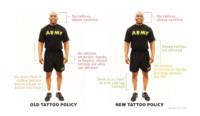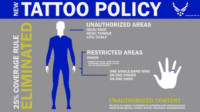The landscape of military tattoo policy is continuously evolving, reflecting shifts in societal norms and the practical needs of recruitment and retention. Recently, the Marine Corps updated its regulations, signaling a broader trend across all U.S. military branches towards more accepting tattoo policies. This adjustment, detailed in the “Marine Corps Bulletin 1020,” now permits “sleeve” tattoos and allows officers to have more than four visible tattoos while in uniform. These changes highlight a significant adaptation to modern trends, acknowledging that a large percentage of young adults today embrace tattoos. This article delves into the specifics of these updated policies across different branches, providing a comprehensive guide for those interested in Military Tattoos, whether as service members or enthusiasts of military culture.
The core reason behind these evolving regulations is pragmatic: attracting and retaining talent. With a considerable portion of the younger demographic sporting tattoos, strict policies were becoming a barrier to recruitment. The Marine Corps, in its bulletin, emphasizes finding a balance between maintaining discipline and decorum and aligning with contemporary society. They state that the revised policy “ensures that the Marine Corps maintains its ties to the society it represents and removes all barriers to entry for those members of society wishing to join its ranks.” This sentiment is echoed across the other branches, leading to a harmonization of tattoo policies.
 Guide to Military Tattoo Policies across US Armed Forces
Guide to Military Tattoo Policies across US Armed Forces
Currently, the tattoo regulations across the Army, Navy, Air Force, Marine Corps, and Coast Guard are largely consistent, with minor variations. While a near-blank canvas isn’t required anymore, certain restrictions remain in place to uphold standards of professionalism and decorum. Let’s break down the common restrictions and the subtle differences between each branch.
Restricted Tattoo Zones Across All Branches
All branches uniformly prohibit tattoos on certain highly visible areas:
- Face: No tattoos are allowed on the face.
- Head & Scalp: These areas are completely restricted from tattoos.
- Tongue, Lips, & Eyelids: Tattoos in or on these areas are prohibited.
While these restrictions are consistent, nuances appear when considering the neck and hands.
Neck Tattoo Policies: A Slight Deviation
The Navy stands out as the only branch permitting a single neck tattoo. This exception is limited to one tattoo, not exceeding one inch in diameter.
However, the Army, Air Force, Marine Corps, and Coast Guard maintain a stricter stance, prohibiting any neck tattoos visible above a crew neck shirt. The Marine Corps further clarifies the neck area as “the portion of the body above the collarbone in the front area, above the seventh cervical vertebrae (C7) in the back area,” ensuring no ambiguity in their policy.
Hand Tattoo Policies: Exceptions and Ring Tattoos
Hand tattoos are generally prohibited across all service branches, but there are specific allowances, primarily for finger ring tattoos.
- Finger Ring Tattoos: The Army, Navy, Coast Guard, and Marine Corps permit one finger ring tattoo per hand. The Marine Corps specifies a maximum width of 3/8 inch for these tattoos. The Coast Guard’s rule is that finger ring tattoos cannot extend beyond the length of the finger from the first to second knuckle.
- Air Force Exception: The Air Force is slightly more restrictive, allowing only a single finger ring tattoo on just one hand.
- Coast Guard’s Additional Hand Tattoo: Uniquely, the Coast Guard allows for one additional hand tattoo, located between the wrist and the first knuckle, and no larger than one inch in diameter.
 US Air Force Tattoo Regulations Example
US Air Force Tattoo Regulations Example
These updated regulations signify a substantial shift from previous policies. It was once common for branches to limit tattoos to less than 25% of exposed body parts and enforce bans on tattoos below the knees or ankles. These widespread restrictions have largely been lifted, reflecting a more permissive environment for military tattoos.
Content Restrictions: What Kind of Tattoos are Prohibited?
While the location and size restrictions have loosened, the content of tattoos remains carefully regulated. The military maintains a firm stance against tattoos that are deemed inappropriate or undermine military values. Specifically, all branches prohibit tattoos that are:
- Racist
- Sexist
- Extremist
- Anti-American
- Ethnically or Religiously Discriminatory
- Obscene
Additionally, tattoos that:
- Signify Gang Affiliation
- Suggest Illegal Drug Use
are also forbidden. Branches articulate these prohibitions with slightly different phrasing. The Coast Guard, for instance, also bans tattoos expressing “Violence” and “Lawlessness.” The Air Force prohibits tattoos that are “prejudicial to good order and discipline, or of a nature that may bring discredit upon the Air Force.”
The Marine Corps’ updated policy specifically broadens the definition of prohibited “terrorism” related tattoos to include domestic terrorism, prohibiting tattoos that “advocate, engage in, or support the forceful, violent, unconstitutional, or otherwise unlawful overthrow of the government of the United States, any state, commonwealth, district, or territory of the United States.”
 US Coast Guard Approved Tattoo Examples
US Coast Guard Approved Tattoo Examples
Ultimately, the interpretation of these content restrictions involves scrutiny at various levels of command, from commanding officers to the Department of Defense. This ensures a thorough review process, particularly for tattoos that might fall into gray areas.
Beyond tattoos, military regulations also address other forms of body art. Practices like branding, burning, scarring, and mutilation are generally prohibited. As the Coast Guard succinctly states, service members are not allowed to have “intentional alterations and/or modifications to a member’s body (e.g. scarring, excessive ear piercing/stretching, tongue splitting, beneath the skin decorative implants, decorative tooth plating/engraving, etc.).”
For those seeking detailed information, official regulations for each branch are available:
- Updates to Marine Corps Tattoo Policy
- Wear and Appearance of US Army Uniforms and Insignia
- United States Navy General Uniform Regulations, Chapter Two, Personal Appearance
- Military Members: Expanded Tattoo Policy (Coast Guard)
- Dress and Personal Appearance of Air Force and Space Force Personnel
In conclusion, while military tattoo policies have become significantly more lenient, understanding the specific regulations of each branch and the overarching restrictions on tattoo content is crucial for current and prospective service members. These updated policies aim to balance individual expression with military standards, reflecting a modern approach to personal appearance within the U.S. Armed Forces.
